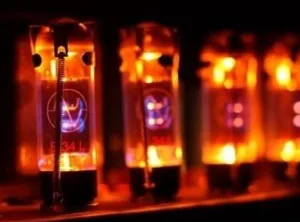
I made reference in my talk at the Nuremberg conference to Paul Gray’s “end of glass, vacuum and metal” (GVM) technology and over the last couple of weeks, I have seen lots of stories that feed that idea.
The first of these technologies to be (largely) replaced by transistors was the thermionic valve (or tube for our US readers). In the 1950s, they were totally dominant in electronics, but were very rapidly driven out by transistors in the 1960s, although they remain in guitar amplifiers, some exotic hi-fi and some high power radio applications. However, their large size, fragile construction, high energy use and high voltages drove them out of the mainstream in a short period.
Image – Shane Gorski/Creative CommonsThe next of the GVM technologies to be superseded was the CRT. Although it might be argued that LCDs are not ‘solid state’, they don’t use metal electrodes, vacuums or high voltage. Certainly, OLEDs are definitely “solid state”. Of course, for quite a few years, the LCD business depended on cold cathode fluorescent lamps (CCFLs), which are GVM technologies, in their backlights, but again these have been almost completely replaced by LED light sources.
In general lighting, the CCFL and the incandescent lamp will be replaced by, at this stage, LED lamps. OLED is currently too expensive to replace the LED, but each of them is a genuinely solid state alternative. My house is currently a mixture of every different lighting technology and I remember seeing a block of apartments at night where the colour of light coming out of every window was different. However, in the fullness of time, our lighting will go solid state too (and may have an even wider range of colours).
Lamps are also very rapidly being replaced by LEDs and lasers. At the recent Prolight & Sound event, which we report on this week, the stage lamps being shown were not based on lamps, but on high power LEDs which are so much more controllable and allow instant switching to provide dramatic effects as well as impressive colour control. Also at that event and at Virtual Laval, Christie, Barco and Digital Projection were highlighting their laser phosphor and direct laser projectors which offer better gamuts, longer life and lower running costs. Of course, lower down in the brightness stakes in projection, LED and hybrid light sources are gradually squeezing the lamp-based projector market.
This week, we have published some early stories from CinemaCon on the website (we’ll carry the full report in the newsletter next week) and news in LDM about an acquisition from Necsel and these stories all highlight the development of laser-based projectors in the cinema field. I’m sure there will be more news next week from NAB. As at Prolight & Sound and ISE, NAB will see lots of LED walls, another solid state technology (although it’s a long time since the Jumbotron GVM technology was displaced).
So, the transition away from GVM is almost complete, although, as with the sudden interest in vinyl records, there are bound to be niche markets that care about the ‘musicality’ of valve-based audio, even though digital modelling is very close to replicating much of the ‘sound of valves’. It’s actually slightly strange that the world of video doesn’t have any significant ‘CRTs are best’ niche market that matches the audiophile and music markets in audio. I guess that the lack of HD and very significant brightness challenges of CRTs make this less likely. Cinema, of course, still has a big ‘film is best’ enthusiast group, and probably always will have.
Bob

